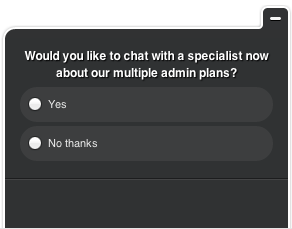Digital surveys continue to flood the internet as businesses embrace a more immediate and impactful approach: Intercept surveys.
As SMS and email surveys wane in effectiveness, intercept surveys step into the limelight, offering a direct line to valuable insights.
Why the shift?
It’s not a single factor but a confluence of intercept survey benefits. Intercept surveys help you:
- Gather contextual feedback like never before
- Zero in on your target audience
- Approach for feedback at the perfect time
It’s the real-time interactions that make intercept surveys a powerful option. Buckle up as we delve into the transformative power of intercept surveys and uncover how they can take your business to new heights.
What Is an Intercept Survey?
Intercept Surveys are online surveys used by businesses on websites to collect customer feedback. Evident from the same, these surveys intercept the user experience by popping on websites as visitors browse.
You can create intercept surveys with questions such as open-ended, close-ended, MCQs, ratings, Likert scale, dichotomous, and the like.
Intercept surveys are an efficient tool for website usability testing, understanding customer behavior and preferences, and gaining a holistic view of your customer experience.
What Are the Types of Intercept Survey Solutions?
Intercept surveys are highly diverse and cater to different business purposes. So, you must clearly understand intercept survey types to leverage them efficiently and interact with your customers.
Overlay Pop-Ups
Overlay popups appear on the screen when users are active on the website. These popups can cover the whole screen or pop up as a slide-in from a corner of the screen.
For example, Qualaroo’s NudgesTM are popup widgets that appear when a trigger action is performed without obstructing the customer experience on the website.
Exit-intent surveys are also overlay popups as they appear as soon as the visitors are about to leave the website.
Website Embed
Website embed surveys are the ones you can add as a part of your website instead of a popup that appears briefly and under specific circumstances.
Website embeds can be the surveys you add to the code of your website, such as the lead generation forms like this:
Another type of website embeds are the survey feedback buttons that you can place anywhere on your website so that they are always visible:
Read More : How to Conduct Successful On Site Surveys on Your Website
Popup Intercept Survey Examples
Popup intercept surveys are prevalent among businesses as they grab visitors’ attention without being pushy or overwhelming.
They also let businesses take a proactive approach to collecting contextual customer feedback. So, here are some intercept survey templates you can consider for your business.
Customer Satisfaction Surveys (CSAT)
Businesses conduct customer satisfaction surveys to gauge the satisfaction level of customers with their services or products. Customer satisfaction is a great metric to track to keep tabs on your user experience.
For CSAT surveys, businesses can use different question types to collect feedback, such as star ratings, emoticons, and a Likert scale of 0 to 5. You can implement branching logic to add more questions and gather contextual feedback.
Net Promoter Score Surveys (NPS)
NPS is a crucial metric for businesses as it helps them identify their promoters and detractors and indicates what kind of experience they offer customers.
NPS surveys consist of the question, “On a scale of 0 to 10, how likely are you to recommend our services/products/brand to your friends?”
Those who rate anything from 0-6 are detractors, 7-8 are passives (neutrals, if you will), and 9-10 are promoters.
Adding a contextual question for your detractors using branching logic will help you understand where you lack in your UX. In doing so, you can try to convert them into promoters or at least avoid making the same mistakes with other customers.
Exit-Intent Surveys
Evident from the name, exit-intent surveys are popup surveys that appear when a visitor is about to leave a website. These surveys help reduce your bounce rate and collect valuable in-context feedback from those who plan to leave.
The feedback you collect with exit-intent surveys can help you identify improvement areas on your landing pages.
Another popular use case for exit-intent surveys is cart abandonment surveys. E-commerce businesses leverage these intercept survey templates to ask visitors why they abandon their cart and leave without making a purchase.
Customer Effort Score Surveys (CES)
Customer effort score surveys help measure how much effort customers have to put into achieving a goal or solving a problem with your product or service. It helps understand your product’s usability and your services’ effectiveness.
User Research Surveys
User research surveys, also known as user experience (UX) surveys, are used by businesses to track the overall quality of users’ experience with your brand and explore their target users.
You can use user research surveys for different purposes, such as:
Buyer persona: You can ask your website visitors a series of questions using popup surveys to collect information that helps you map your buyer personas.
You can create surveys with demographic questions to segregate the buyer personas as per their demographic.
Marketing research: These surveys help you perform competitor analysis and explore new ways to improve your products/services.
Sign-up Forms
Sign-up forms are popup surveys used to collect customer data such as email ID, contact info, etc., and build the email list and newsletter subscribers. These surveys facilitate lead generation.
Also Read - 25+ Essential Lead Generation Tools Your Business Needs Now
What Are the Intercept Survey Advantages?
Although we’ve covered a lot, one major question remains unanswered: “Why should you use intercept surveys for your business?” To answer your question, here are some intercept survey advantages for your business.
Real-Time Responses From Visitors
The eyes have turned on intercept surveys for all the right reasons. One of them is that they engage active users instead of targeting the ones who left the website.
Unlike email surveys or those sent via SMS through links, intercept surveys show up on users’ screens when they are active on the website or mobile app.
This way, customers can’t ignore the surveys, nor will they forget to take them. It’s not like you can’t send a follow-up email for your email survey to remind customers to take it, but isn’t it better if you don’t have to?
You get unfiltered, unaltered, fresh, and on-spot feedback from users about their experience that’s still raw in their minds.
CASE STUDY: GUMTREE
Gumtree is an advertisement and community website where advertisers can promote their products. The team at GumTree wanted to understand what kind of experience customers have on the website so they could improve it further.
Enters Qualaroo’s Nudge surveys.
GumTree conducted customer satisfaction surveys to collect real-time feedback and segment the customers based on category, location, and interest.
Thanks to quick feedback, Gumtree successfully followed the agile approach to enhance its website and experience.
You can further read how Qualaroo’s integration with Tableau streamlined the analysis process for GumTree here.
Prioritize Timing Without Being Intrusive
The biggest criticism of intercept surveys lies in their potential to be disruptive and intrusive.
It’s reasonable for visitors to feel irritated when a popup survey interrupts their web browsing or use of an application.
Nevertheless, recent advancements in intercept survey tools have alleviated these concerns by introducing more passive popup designs.
For instance, intercept surveys from Qualaroo not only appear strategically during a visitor’s interaction with a website or application but also do so in a manner that doesn’t negatively impact the overall user experience.
Increase Response Rate
Email and SMS surveys are limited in their reach as they only target customers who have provided some information to contact them, i.e., email ID and mobile number. But unlike the other counterparts, intercept surveys bypass this requirement altogether.
They have access to a large audience since they can target all website visitors without requiring customer data.
More so, need we say that these surveys are hard to ignore? They offer solid call-to-action for respondents, boosting customer engagement.
CASE STUDY: UNIVERSITY OF ALBERTA
The news column of the University of Alberta’s website had 50,000 page views every month with only about 500 subscribers. Unusual, isn’t it?
The problem is that the website has traffic but nothing engaging enough to motivate those visitors to subscribe. Some visitors might not even know why they should subscribe to the newsletter or if there is one to begin with.
Nudges to the rescue.
The university launched Qualaroo’s popup surveys on their website, asking visitors if they would like to sign up for the newsletter (solving the problem of visitors not knowing about it). They used branching logic to direct the visitors to the following survey popup based on their responses.
For example, if the visitors say ‘Yes,’ a popup will appear to collect their email addresses. If they say ‘No, thanks,’ a thank you message will appear. This way, UAlberta saw a spike of 500% in their email subscribership.
Target Different Demographics
Intercept surveys are more than just basic targeting. You can either show them to all your website visitors or target a specific demographic using tools like Qualaroo that offer advanced targeting and conditional logic.
You can set target requirements so your surveys only show up to visitors from the selected demographic or category. This way, you can create tailored strategies to target customers from all demographics for different purposes.
For example,
- You can perform A/B testing and show variations to your website traffic based on the criteria or the demographic you want to test.
- Create screening surveys to zero in on your core audience and gather their feedback.
CASE STUDY: AWA DIGITAL (CANON)
AWA Digital is an agency that helps its clients improve sales. Canon, one of their clients and a leading consumer electronics company wanted to boost product demand in different countries.
AWA Digital turned to Qualaroo to use surveys to get an idea about Canon’s customers in different countries and understand their needs, wants, preferences, and challenges.
The agency launched surveys on Canon’s website, asking various questions to the customers about different product lines.
The survey feedback highlighted that some customers don’t purchase due to the prices of the cameras, and for some people, authenticity and reputation are paramount.
To encourage customers to shop from different countries, AWA Digital nipped the messaging for different regions based on the feedback and personalized the marketing for different demographics.
Doing so enabled the agency to find upselling opportunities. All these efforts resulted in a 700% increase in ROI.
Also Read: Top 20 A/B Testing Mistakes People Make but You Won’t in 2024
FREE. All Features. FOREVER!
Try our Forever FREE account with all premium features!
How to Create Intercept Surveys in 7 Easy Steps
Now that you know the benefits of creating intercept surveys, why don’t we move on to creating one? Let’s take a look at the step-by-step intercept survey method.
Step 1: Select the “Create New” option on the top-right corner of the dashboard.
Step 2: Pick any NudgeTM type depending on the platform you want to target, i.e., prototype, desktop, mobile web, Android, and iOS apps, by selecting “Choose Template.” If you want to create a survey from scratch, choose “New from scratch.”
*Note: For demonstration, we’ll use the Desktop Web Nudge templates.
Step 3: Click “Choose Template” and select any survey template you want from a wide selection of surveys. Select “Use This Template.”
Step 4: Now, you can customize, edit, and add questions like radio buttons, Likert Scale, multiple-choice, dichotomous, open-text, etc.
Step 5: Click next to move to the “Targeting” menu.
It is where you can leverage advanced targeting to target the right audience and demographics for your surveys. Choose “Use a simple URL” and add the website URL where you want to launch your survey. If you want to target any specific page, click “Use an advanced URL.”
Step 6: Once done with targeting, click on the ‘Design’ option.
You can customize your popup surveys as per your branding to give them the in-house touch.
Step 7: When you complete the survey, click the “Save” button to save your survey on the dashboard and make it live whenever you want.
Best Practices to Follow for Intercept Surveys
Considering a few tips while designing and conducting survey intercepts will help you avoid survey errors and conduct your research efficiently. Here are a few intercept survey best practices for you to consider.
Explore Which Is Better for You: Survey Widgets or Pop-Ups
Popup surveys and feedback widgets are both phenomenal choices to collect customer insights and know what they think about your business, products, and services.
Which of these two you should choose depends on what you want to accomplish. For example, if you want to pulse-check customers or collect contextual feedback, without a doubt, go with popup surveys.
On the other hand, if you want to offer an option to customers to give their feedback voluntarily, you can leverage the survey widget.
The secret here is you can use both.
You can add the feedback widget anywhere on the website and launch popup surveys with triggers. This way, customers can proactively share their feedback, and you can also collect specific feedback.
Spread Surveys Throughout Different Touchpoints
Why limit yourself to collecting feedback on your homepage or a specific landing page when you can do so throughout the customer journey?
While email and SMS gateway are highly limited in getting you diverse feedback, website intercept surveys pose no such limitation.
From user research, lead generation, and sales to onboarding and post-purchase, you can get a holistic view of customer experience.
For example:
- You can start by learning about your customers and creating customer personas.
- Popup surveys can help you target the ideal website visitors with surveys. You can ask about their specific needs, create a tailored experience for them, and generate quality leads.
- You can collect customer feedback after purchasing to improve your checkout process further.
- You can assist new users during onboarding and get them acquainted with your products and services.
- Ask customers about their experience with customer support to ensure all their issues are addressed timely.
Design Goal-Centric Survey Questions
The feedback data’s relevancy and effectiveness depend on what questions you ask.
Why? Because users’ feedback depends on what and how you ask. For instance, merely asking customers to rate their satisfaction won’t cut it if you want qualitative insights about them, such as their experience.
You’ll need to follow up with another open-ended question to collect qualitative feedback insights.
More so, you can frame your questions depending on your objective. For example, is your objective:
- To track customer satisfaction metrics?
- Understand visitors’ behavior on a website?
- Capture the first impression?
Your site intercept survey should reflect what you want to achieve with your intercept survey questions.
Keep Your Intercept Surveys Short
If we ask you to take a 10-question survey, would you take it?
We know you’d instead check your stocks online.
In the same way, customers don’t engage or at least complete overwhelmingly long surveys.
So, what should you do?
It’s better to create short, one-question surveys with a few follow-up questions rather than long-form surveys. Short-form surveys are easy to take, so visitors are more likely to complete them.
Show Relevant Surveys to Customers
Nothing is more off-putting for users than an irrelevant, waste-of-time survey. For instance, you wouldn’t be impressed with a company that asks you how the checkout process works even before you’ve made a purchase.
Sloppy and unthoughtful, right?
Sometimes, businesses make mistakes while setting targeting parameters for their popup surveys. So, always ensure to show relevant surveys throughout customer journey touchpoints.
If you want to ensure your surveys do the job well, consider the common survey errors you are prone to make and how to avoid them. This way, you’ll be able to create flawless surveys that get accurate customer data.
Intercept Survey Questions to Ask
Now that you know how to create an intercept survey, it’s time to move on to the intercept survey solution questions that you can use.
Intercept Survey Questions for Market/User Research:
- Is our brand’s purpose clear to you?
- Which brand of [product/service] do you prefer?
- When you hear [product name], which brand immediately comes to mind?
- How much would you expect to pay for the Product/Service?
- What have you heard (positive and negative) about our company/products?
- Why do you prefer to purchase from us?
- Have you heard of our products/services before? If so, how did you come across our brand?
Intercept Survey Questions to Ask Your Leads:
- What was your first impression of interaction with our company?
- Is there anything on this website that doesn’t work as you expected?
- What are your biggest challenges with the current market solutions?
- What problems/pain points are you trying to solve?
Intercept Survey Questions to Ask Pre-Purchase:
- Is our pricing clear?
- Did you find enough/appropriate information about our products/services?
- What stopped you from purchasing today?
- Is there anything we can do to help you complete the purchase process?
Intercept Survey Questions to Ask After Purchase:
- Please tell us how we can improve our checkout process.
- How would you rate your purchasing experience with us?
- How likely are you to purchase our product/service again?
- Please briefly explain your last experience with us.
- What’s the one thing that almost stopped you from buying from us?
Intercept Survey Questions to Ask at the Onboarding Stage:
- Was our onboarding process helpful?
- Was there anything critical to your success we didn’t cover during our onboarding process?
- Do you feel our product is going to help you achieve your goals?
- How easy was it for you to use our product the first time?
Intercept Survey Questions to Ask for Product Experience:
- How can we make [product/service] easier to use?
- What would it be if you could change one thing about [product/service]?
Intercept Survey Questions to Gauge Customer Experience:
- Is the quality of our products up to the mark?
- How would you feel if you could no longer use our product/service?
- How was your overall experience shopping with us?
- On a scale of 0-10, how likely are you to recommend our brand/product/service to your friends and family?
Know Your Customers Contextually With Intercept Surveys
Getting to know your customers is the first step in building a strong connection, and intercept surveys take this to the next level. Unlike regular surveys, intercept surveys let businesses collect feedback and understand what customers experience at every step.
With new online tools, businesses can use personalized popups that target specific groups of website visitors. This way, they can check in with customers, see how they feel, and make improvements to enhance their experience.
So, instead of just asking questions, let’s have a chat with our customers using intercept surveys—a powerful tool that helps businesses put customers at the center of everything and find great success.
Frequently Asked Questions
How do you plan a UX survey?
Planning a UX survey involves defining objectives, identifying participants, selecting survey type, creating hypotheses, designing clear questions, choosing survey tools, pilot testing, setting a timeline, distributing effectively, analyzing results, implementing changes, and communicating findings. This systematic approach ensures meaningful insights for enhancing the user experience.
What response rate is good for a survey?
A response rate of 20% or higher is generally considered good for a survey. However, the ideal rate can vary depending on factors like the target audience, intercept survey method and the distribution type. Aim for a response rate that ensures a representative sample and meaningful insights.
FREE. All Features. FOREVER!
Try our Forever FREE account with all premium features!

 We'd love your feedback!
We'd love your feedback! Thanks for your feedback!
Thanks for your feedback!






